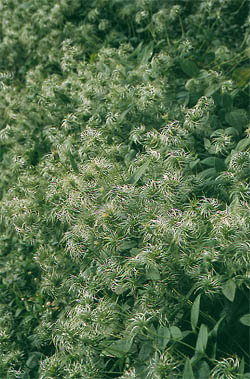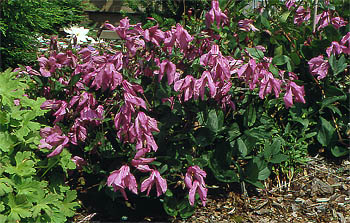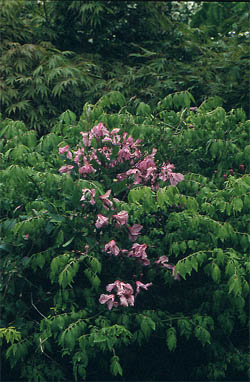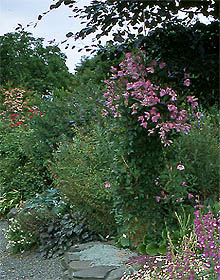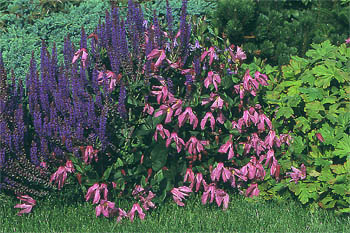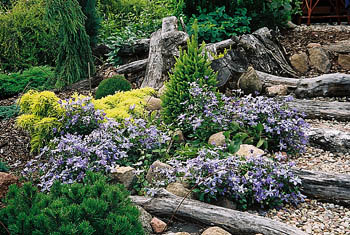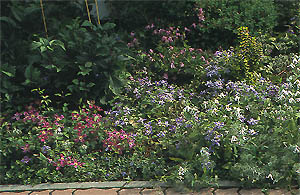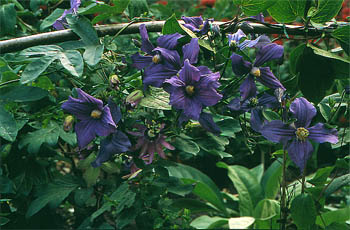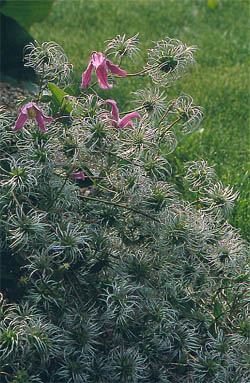SOLITARY CLEMATIS AND THE WHOLE CLEMATIS INTEGRIFOLIA GROUP
I would like to recommend to all solitary clematis, along with many cultivars and hybrids selected from it. Though still little known, they are very valuable and attractive on the basis of their long and profuse flowering, healthiness, hardiness and easy culture.
Szczepan Marczyński
Solitary clematis adapt well to all the familiar garden uses, but can also be successfully grown on balconies, patios and in areas of public greenery. They are non-clinging in habit with stems, depending on a variety, between 40 to well over 200 cm long, and will meander through a border and amongst existing plants in a delightful manner, adding interest to shrubs that have finished flowering, such as azaleas. These shrubs flower beautifully but shortly in early spring, and afterwards form a monotonous mass of green until autumn when their leaves variegate. If you grow them together with Clematis integrifolia, and prune clematis to the lowest buds in spring, it will not become noticeable until azaleas flowers are over. In the summer, however, the plant will be veiled with billowing clouds of flowers followed by an attractive crop of ornamental seedheads. Clematis from this group are also charming companions for border roses and other shrubs and prove invaluable in creating groups and borders. When grown without support, they will spread out over the ground creating attractive covers.
Solitary clematis (Clematis integrifolia) is a slender-stemmed, scrambling perennial with stems reaching up to 1 m. From June to September the plant covers with bell-shaped nodding violet flowers with recurving tepals, followed by fluffy seedheads later in the season. The species grows in the wild in southeast Europe, e.g. in Hungary. Generally healthy and hardy, it’s quite undemanding and easy to grow. As in the case of other perennials, its stems die down to the ground each year and they should be cut back at the ground level in early spring.
‘Alba’ is a white-flowered selected form of the species.
A number of very attractive hybrids have been selected from solitary clematis, all retaining the immunity and healthiness of the species.
In 1835 J.A. Henderson crossbred Clematis integrifolia with Clematis viticellaproducing Clematis x diversifolia ‘Hendersonii’ – a beautiful perennial clematis, semi-herbaceous in habit, the oldest hybrid in cultivation. It has deep bluish-purple bell-shaped slightly nodding flowers with yellow stamens. Free flowering from June to September. It’s an excellent companion plant for deciduous and coniferous shrubs.
Many years later the cultivar ‘Blue Boy’ with slightly darker flowers was obtained through similar crossbreeding.
In 1870 Duran Freres raised Clematis x durandii as a cross between Clematis integrifolia and Clematis lanuginosa. This beautiful hybrid has fairly large (7-14 cm in diameter) deep blue, bell shaped flowers that become flat when fully open. It looks lovely both tied to a support and intermingled with other plants and makes an excellent cut flower.
In the 1870’s a new seedling originating from a chance cross between Clematis integrifolia and Clematis flammula (Clematis recta) was discovered and given the name Clematis x aromatica. This graceful climber has small, strongly fragrant flowers. Dark bluish-violet sepals contrast nicely with long creamy stamens. It prefers well-lit sunny sites and permeable well-drained soils. On account of its sweet scent it’s ideal for planting near windows, park benches and other popular places of social gatherings.
A number of other attractive forms included in the Integrifolia Group were propagated from wild seedlings, the products of chance crosses of Clematis integrifolia. They are all excellent for perennial borders and as companion plants for shrubs.
- ‘Bluish Violet’ – with dark violet-blue flowers;
- ‘Hakuree’ – a Japanese cultivar. Slightly scented, bell-shaped flowers of white tinged with lavender are borne from June to September;
- ‘Hanajima’ – A slender-stemmed variety originating from Japan. Bell-shaped nodding pink flowers with long twisted tepals are borne from June to September, followed by silky seed heads.
- ‘Juuli’ – An Estonian variety. Purple blue flowers early in the season, in full blossom become blue with a lilac-blue central bar. Golden anthers on white filaments. Very free flowering from July to September. Thrives in all aspects. Hard pruning required.
- ‘Olgae’ – blue-violet, slightly-scented flowers;
- ‘Rosea’ – vivid pink flowers;
In the recent years as an effect of crossbreeding Solitary Clematis with large-flowered varieties many valuable and popular hybrids have been obtained. The following is a particularly attractive on account of its long and profuse flowering:
- ‘Arabella’ (1994) – a lovely variety originating from England. From June to October mid-blue flowers with conspicuous cream anthers are abundantly scattered over the whole plant. Very free flowering over a long period. It has raised, non-clinging stems (as in climbing rose), and when no support is provided, it will scramble over the ground. It looks lovely when intermingled with another plants. A hardy cultivar, excellent as ground cover, or for growing on terraces.
Other popular throughout the world varieties include:
- ‘Alionushka’ – raised in Ukraine, it has bell-shaped, nodding, rose-pink flowers from June to September. It can grow up to 1-1.5 m in height.
- ‘Pamiat Serdtsa’, like ‘Alionushka’, was raised in Ukraine. The size and looks is also similar, but the flowers are violet-lilac.
- ‘Inspiration’ was bred in Holland as a cross between Clematis integrifolia and ‘Warszawska Nike’. It has flowers of an unusual hue of dark pink, with twisted tepals and contrasting yellow stamens that bloom from June to September. It’s best hard pruned. Suitable for every aspect.
- ‘Rooguchi’ is a charming variety produced in Japan by crossbreeding Clematis integrifolia and Clematis reticulata. In 2001 it created a sensation in Great Britain. Graceful, bell-shaped, deep violet-blue flowers edged in pale mauve are borne incessantly from June to October. Stems don’t twine round supports, but they can lean against them. The plant can be either stimulated to grow higher with the help of some string or wire, or left to scramble at ground level. Ideal for meandering through perennials and shrubs, it is also suitable for large containers. Makes a good ground container plant. If there is one drawback with this variety, it is its susceptibility to powdery mildew.
All the described varieties are easy to grow. They will certainly add interest to any garden by filling empty spaces with multicolored carpets throughout the summer.
- Clematis Integrifolia Group ‘Alba’ – seedheads
- Clematis Integrifolia Group ‘Alionushka’
- Clematis Integrifolia Group ‘Alionushka’
- Clematis Integrifolia Group ‘Alionushka’
- Clematis Integrifolia Group ‘Alionushka’
- Clematis Integrifolia Group ‘Arabella’ (1994)
- Clematis Integrifolia Group ‘Rosea’, ‘Arabella’ (1994) and others
- Clematis x durandii
- Clematis Integrifolia Group ‘Rosea’ – seedheads

